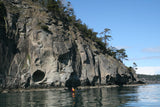Explore Victoria: Sidney Spit
Sidney Island is one of the great recreational opportunities within Greater Victoria, offering a mix of sandy beaches to stroll, forests to hike, open fields to camp upon and docks and mooring buoys for visiting boaters. It is particularly well suited for kayakers, being just a short crossing from launch points near the town of Sidney. Regular foot passenger service makes it accessible to backpackers and daytrippers.
The park is part of the Gulf Islands National Park Reserve, covering the long drying flats, the lagoon and a forested upland. The majority of the island is private property, though, with a fence along the park boundary marking the division. The most popular area is the southern spit; day-tripping boaters will line the shore, creating a party atmosphere on hot summer days.
Ecology: Smelt, also called sandlance, reproduce in the lagoon’s sand, attracting sandpiper, murrelet, auklet, cormorant, gull and other shorebirds each summer. This is one of the top bird habitats in the Salish Sea. Brandt cormorant stop here on the fall migration and mew gull and brant geese during the spring migration. The beaches are also a great place to see great blue heron. Dozens regularly feed here. Boaters are asked to stay outside the lagoon to protect the wildlife.
Hiking: A trail rounds the park and leads to lookouts over from the bluffs on the northern side of the island as well as to the inner lagoon.
History: On the north side of the lagoon are remnants of Sidney Island Brick and Tile, founded in 1906. The bricks were used in projects such as the Empress Hotel and Hotel Vancouver until the factory went bankrupt in 1925. Bricks, building foundations and equipment are still scattered along the shorefront. Hidden deeper within the park is a bomb shelter from the Second World War, built because James Island, as an explosives manufacturing site, was considered a target. It lies off the main path east of the camping area in an open field.
Camping: Camping is in an open, grassy clearing near the lagoon or in a grass field above a berm. Group camping for 15 or more is available in a field set back from the water.
Mandarte Island: This elongated rocky island is the perfect environment for nesting birds. Residents include double-crested cormorant, pelagic cormorant, glaucous-winged gull and pigeon guillemot. It is also one of just a few places on the BC coast where the tufted puffin is known to breed. The island is a Tsawout and Tseycum reserve but maintained as a seabird reserve and research area, and one of the few on a short list of seabird nesting areas in BC.











